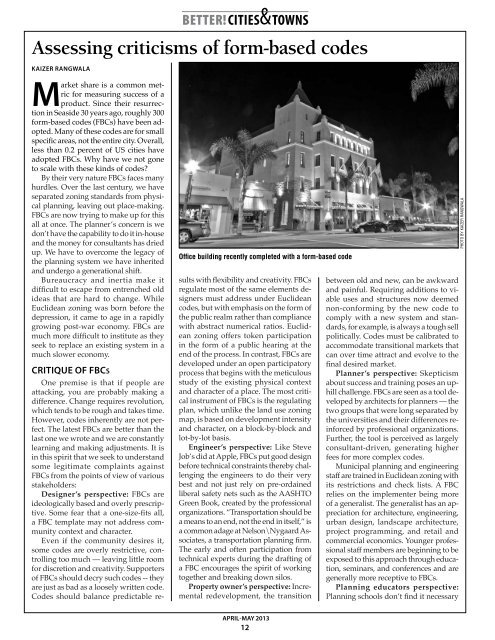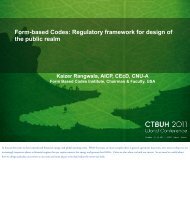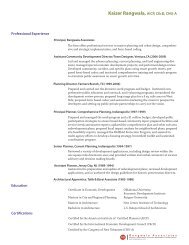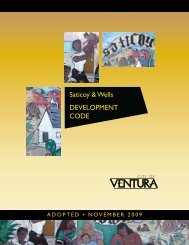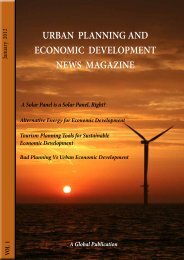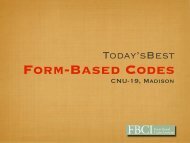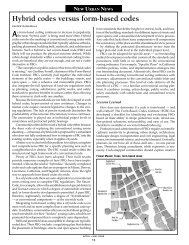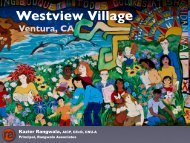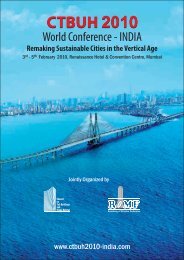Assessing criticisms of form-based codes - Rangwala Associates
Assessing criticisms of form-based codes - Rangwala Associates
Assessing criticisms of form-based codes - Rangwala Associates
Create successful ePaper yourself
Turn your PDF publications into a flip-book with our unique Google optimized e-Paper software.
etter! cities<br />
towns<br />
<strong>Assessing</strong> <strong>criticisms</strong> <strong>of</strong> <strong>form</strong>-<strong>based</strong> <strong>codes</strong><br />
Kaizer <strong>Rangwala</strong><br />
&<br />
Market share is a common metric<br />
for measuring success <strong>of</strong> a<br />
product. Since their resurrection<br />
in Seaside 30 years ago, roughly 300<br />
<strong>form</strong>-<strong>based</strong> <strong>codes</strong> (FBCs) have been adopted.<br />
Many <strong>of</strong> these <strong>codes</strong> are for small<br />
specific areas, not the entire city. Overall,<br />
less than 0.2 percent <strong>of</strong> US cities have<br />
adopted FBCs. Why have we not gone<br />
to scale with these kinds <strong>of</strong> <strong>codes</strong>?<br />
By their very nature FBCs faces many<br />
hurdles. Over the last century, we have<br />
separated zoning standards from physical<br />
planning, leaving out place-making.<br />
FBCs are now trying to make up for this<br />
all at once. The planner’s concern is we<br />
don’t have the capability to do it in-house<br />
and the money for consultants has dried<br />
up. We have to overcome the legacy <strong>of</strong><br />
the planning system we have inherited<br />
and undergo a generational shift.<br />
Bureaucracy and inertia make it<br />
difficult to escape from entrenched old<br />
ideas that are hard to change. While<br />
Euclidean zoning was born before the<br />
depression, it came to age in a rapidly<br />
growing post-war economy. FBCs are<br />
much more difficult to institute as they<br />
seek to replace an existing system in a<br />
much slower economy.<br />
Critique <strong>of</strong> FBCs<br />
One premise is that if people are<br />
attacking, you are probably making a<br />
difference. Change requires revolution,<br />
which tends to be rough and takes time.<br />
However, <strong>codes</strong> inherently are not perfect.<br />
The latest FBCs are better than the<br />
last one we wrote and we are constantly<br />
learning and making adjustments. It is<br />
in this spirit that we seek to understand<br />
some legitimate complaints against<br />
FBCs from the points <strong>of</strong> view <strong>of</strong> various<br />
stakeholders:<br />
Designer’s perspective: FBCs are<br />
ideologically <strong>based</strong> and overly prescriptive.<br />
Some fear that a one-size-fits all,<br />
a FBC template may not address community<br />
context and character.<br />
Even if the community desires it,<br />
some <strong>codes</strong> are overly restrictive, controlling<br />
too much — leaving little room<br />
for discretion and creativity. Supporters<br />
<strong>of</strong> FBCs should decry such <strong>codes</strong> -- they<br />
are just as bad as a loosely written code.<br />
Codes should balance predictable re-<br />
Office building recently completed with a <strong>form</strong>-<strong>based</strong> code<br />
sults with flexibility and creativity. FBCs<br />
regulate most <strong>of</strong> the same elements designers<br />
must address under Euclidean<br />
<strong>codes</strong>, but with emphasis on the <strong>form</strong> <strong>of</strong><br />
the public realm rather than compliance<br />
with abstract numerical ratios. Euclidean<br />
zoning <strong>of</strong>fers token participation<br />
in the <strong>form</strong> <strong>of</strong> a public hearing at the<br />
end <strong>of</strong> the process. In contrast, FBCs are<br />
developed under an open participatory<br />
process that begins with the meticulous<br />
study <strong>of</strong> the existing physical context<br />
and character <strong>of</strong> a place. The most critical<br />
instrument <strong>of</strong> FBCs is the regulating<br />
plan, which unlike the land use zoning<br />
map, is <strong>based</strong> on development intensity<br />
and character, on a block-by-block and<br />
lot-by-lot basis.<br />
Engineer’s perspective: Like Steve<br />
Job’s did at Apple, FBCs put good design<br />
before technical constraints thereby challenging<br />
the engineers to do their very<br />
best and not just rely on pre-ordained<br />
liberal safety nets such as the AASHTO<br />
Green Book, created by the pr<strong>of</strong>essional<br />
organizations. “Transportation should be<br />
a means to an end, not the end in itself,” is<br />
a common adage at Nelson\Nygaard <strong>Associates</strong>,<br />
a transportation planning firm.<br />
The early and <strong>of</strong>ten participation from<br />
technical experts during the drafting <strong>of</strong><br />
a FBC encourages the spirit <strong>of</strong> working<br />
together and breaking down silos.<br />
Property owner’s perspective: Incremental<br />
redevelopment, the transition<br />
between old and new, can be awkward<br />
and painful. Requiring additions to viable<br />
uses and structures now deemed<br />
non-con<strong>form</strong>ing by the new code to<br />
comply with a new system and standards,<br />
for example, is always a tough sell<br />
politically. Codes must be calibrated to<br />
accommodate transitional markets that<br />
can over time attract and evolve to the<br />
final desired market.<br />
Planner’s perspective: Skepticism<br />
about success and training poses an uphill<br />
challenge. FBCs are seen as a tool developed<br />
by architects for planners — the<br />
two groups that were long separated by<br />
the universities and their differences reinforced<br />
by pr<strong>of</strong>essional organizations.<br />
Further, the tool is perceived as largely<br />
consultant-driven, generating higher<br />
fees for more complex <strong>codes</strong>.<br />
Municipal planning and engineering<br />
staff are trained in Euclidean zoning with<br />
its restrictions and check lists. A FBC<br />
relies on the implementer being more<br />
<strong>of</strong> a generalist. The generalist has an appreciation<br />
for architecture, engineering,<br />
urban design, landscape architecture,<br />
project programming, and retail and<br />
commercial economics. Younger pr<strong>of</strong>essional<br />
staff members are beginning to be<br />
exposed to this approach through education,<br />
seminars, and conferences and are<br />
generally more receptive to FBCs.<br />
Planning educators perspective:<br />
Planning schools don’t find it necessary<br />
photo by Kaizer <strong>Rangwala</strong><br />
April-May 2013<br />
12
etter! cities<br />
&<br />
towns<br />
photo by Kaizer <strong>Rangwala</strong><br />
to teach physical planning as a core competency for a pr<strong>of</strong>essional<br />
planner. A few years ago the Planning Accreditation<br />
Board debated removing urban design as a core requirement<br />
for planners. In cases where planning schools are housed with<br />
architectural schools, the architects don’t teach FBCs because it<br />
constrains creative process <strong>of</strong> object buildings.<br />
Pr<strong>of</strong>essional organizations: Most members within pr<strong>of</strong>essional<br />
organizations use Euclidean zoning so switching to FBC<br />
would be going against the norm. However we have tried<br />
the Euclidean framework for almost 100 years. It has failed to<br />
produce places <strong>of</strong> lasting value and is not likely to repair and<br />
restore the failing commercial corridors, <strong>of</strong>fice parks, shopping<br />
districts, and subdivisions. Codes are the number one tool<br />
for implementation and planners are in charge <strong>of</strong> the <strong>codes</strong>.<br />
Pr<strong>of</strong>essional organizations can provide leadership in the field<br />
<strong>of</strong> regulatory re<strong>form</strong>.<br />
Misconceptions<br />
The failure to understand the purpose and technique <strong>of</strong><br />
FBCs cause many to stand on the sidelines. Common misunderstandings<br />
include:<br />
FBCs are too restrictive<br />
FBCs’ focus on physical vision is perceived to force a narrow<br />
range <strong>of</strong> design options. However, both FBCs and conventional<br />
<strong>codes</strong> establish controls on development. FBCs emphasize standards<br />
that shape the collective public realm and <strong>of</strong>fer a great<br />
deal <strong>of</strong> flexibility in the individual private realm. Standards for<br />
the public realm are <strong>based</strong> on community’s vision. Conversely,<br />
Euclidean <strong>codes</strong> control the use <strong>of</strong> the private realm with vague<br />
standards that fail to conceptualize a cohesive public realm.<br />
FBCs’ clear and precise standards, streamlined and predictable<br />
process, and predictable outcomes have opened development<br />
potential within numerous communities.<br />
They ignore market realities<br />
It is a widely known best practice to study the market<br />
potential before developing regulations. Market studies are<br />
more common with <strong>form</strong>-<strong>based</strong> than conventional Euclidean<br />
<strong>codes</strong>. In <strong>form</strong>-<strong>based</strong> coding, it is much easier to align the <strong>form</strong>,<br />
uses, building types, and infrastructure with market potential.<br />
Why? Because FBCs are an end-to-end integrated product that<br />
brings together the various disciplines <strong>of</strong> planning, design,<br />
economic development, engineering, and public safety early<br />
on to per<strong>form</strong> in unison. It becomes possible to analyze the<br />
community-supported vision from every point <strong>of</strong> view, to<br />
Form-<strong>based</strong> grocery store in Ventura, California<br />
figure out the cost, and understand how various public and<br />
private partners can implement that vision. The results are<br />
therefore more predictable. At the same time, a lighter focus<br />
on use allows buildings to be nimble to the market.<br />
A one-trick pony<br />
A common misunderstanding is that FBC practitioners use<br />
the same playbook with one protocol, method, and template<br />
for every situation. Some critics find FBCs appropriate only for<br />
greenfield sites, and not appropriate in urban areas.<br />
While the language <strong>of</strong> coding is common, practitioners<br />
employ different syntax and dialects. FBCs can be used to<br />
protect or trans<strong>form</strong> an area. The applications range from the<br />
region to the neighborhood, integrated by a common thread<br />
to creating authentic, livable and lasting places.<br />
Conceivably, FBCs could be written to facilitate sprawl.<br />
Similarly, the integrated plat<strong>form</strong> <strong>of</strong> FBCs is better equipped<br />
to address the natural environment, affordable housing, and<br />
historic preservation. But if for some reason a community<br />
decides to not address these issues in their <strong>codes</strong>, this is not a<br />
weakness <strong>of</strong> the tool, but operator’s error.<br />
Hybrid just sounds better<br />
Hybrid implies the best <strong>of</strong> both worlds with more flexibility<br />
and less controversy. The term “hybrid code” confuses people<br />
as it has been used in a couple <strong>of</strong> ways. The first use <strong>of</strong> hybrid<br />
code is the method in which design guidelines or standards<br />
are added to a Euclidean zoning <strong>form</strong>at. Despite the attempt<br />
to introduce design, the focus <strong>of</strong> such <strong>codes</strong> continues to be<br />
on control <strong>of</strong> density and uses. This option leaves lots <strong>of</strong> room<br />
for subjective judgment when the <strong>codes</strong> are applied thereby<br />
compromising clarity, and predictable outcomes and processes.<br />
Avoiding tough issues for more flexibility fails to produce the<br />
results imagined in the vision and disillusions the public to<br />
question the efficacy <strong>of</strong> coding and planning.<br />
In the second preferred option, also referred to as hybrid<br />
<strong>codes</strong>, FBCs are adopted for small areas within a city where<br />
walkable urbanism is desired. These FBCs are carefully integrated<br />
into the existing citywide Euclidean zoning plat<strong>form</strong>.<br />
This option really does <strong>of</strong>fer the best <strong>of</strong> both worlds.<br />
What can we do to fix it?<br />
We should ensure that the different pr<strong>of</strong>essional organizations,<br />
media, conference organizers, seminar instructors, and<br />
the public get the facts correct. People will report what they<br />
hear, so it is important they have the correct in<strong>form</strong>ation and<br />
easy access to the experts who understand <strong>form</strong>-<strong>based</strong> <strong>codes</strong>.<br />
Plenty <strong>of</strong> factual in<strong>form</strong>ation exists and should be channeled<br />
to get proper media coverage.<br />
FBC practitioners should refrain from overselling FBCs. It’s<br />
only a tool — not a panacea for the absence <strong>of</strong> good planning.<br />
Overselling hurts the product, as focus shifts to what it cannot<br />
do versus what it can do. People resist agenda-driven influences,<br />
if <strong>of</strong>fered “fixes” they do not want or need. It’s more<br />
effective to influence than persuade. Our focus is to inspire<br />
lasting buy-in and commitment by painting a picture <strong>of</strong> a better<br />
place. In addition, practitioners must be prepared for lengthy<br />
follow-up sessions with implementing staff. This may include<br />
training sessions and assistance with project review.<br />
Planners should reclaim their heritage in physical planning<br />
April-May 2013<br />
13
etter! cities<br />
&<br />
towns<br />
and design and lead this effort. Unlike conventional Euclidean<br />
<strong>codes</strong>, FBCs require multidisciplinary skill sets. Overcoming<br />
the usual disconnect between planning and design, large cities<br />
such as Nashville, Portland, Seattle, Boston, Los Angeles,<br />
Chattanooga, Charlotte and many others have urban design<br />
studios that are involved in design <strong>of</strong> spatial elements for<br />
short- and long-range planning projects. Smaller cities can<br />
bring attention to the design and coding <strong>of</strong> the public realm<br />
by bringing on a staff urban designer, landscape architect, or<br />
town architect.<br />
Planning organizations and universities should <strong>of</strong>fer urban<br />
design as a core course and the planner’s certification exam<br />
should test for competency with physical planning.<br />
Conclusion<br />
Market share is not the only metric for measuring success.<br />
Easy to use great products that have the ability to change<br />
people’s lives prevail in the long run. In 2010, Apple surpassed<br />
Micros<strong>of</strong>t as the world’s most valuable technology company.<br />
It had just 7 percent <strong>of</strong> the personal computer market but it<br />
boasted 35 percent <strong>of</strong> the operating pr<strong>of</strong>its. The market for<br />
PCs is shrinking while Macs are growing. As fuel prices soar<br />
over the next few decades, municipalities must be prepared<br />
to shift to a much more sustainable urban <strong>form</strong>. This can be<br />
accomplished with FBCs.<br />
The good news is that the majority <strong>of</strong> these <strong>codes</strong> have been<br />
adopted in the past 10 years, so there is momentum. “As the<br />
economy recovers and more built results can be seen, this will<br />
likely cause an escalation <strong>of</strong> demand for FBCs,” says Carol<br />
Wyant Executive Director <strong>of</strong> the Form Based Code Institute.<br />
In recent years, a number <strong>of</strong> big cities have either adopted or<br />
are developing FBCs — this has raised the FBC pr<strong>of</strong>ile and is<br />
inspiring others to follow suit. ◆<br />
Kaizer <strong>Rangwala</strong>, AICP, CEcD, CNU-A, is the founding principal<br />
<strong>of</strong> <strong>Rangwala</strong> <strong>Associates</strong>, and a member <strong>of</strong> the board <strong>of</strong> directors<br />
<strong>of</strong> the Form-Based Codes Institute, which seeks to advance the<br />
knowledge and use <strong>of</strong> <strong>form</strong>-<strong>based</strong> <strong>codes</strong>.<br />
Suburban infill development connects with nature<br />
New Urban Builders, <strong>based</strong> in<br />
Chico, California, had big development<br />
plans prior to the<br />
housing crash — but those plans were<br />
put in indefinite hold. Now the firm is<br />
dipping a toe back into single-family<br />
housing with a 24-unit suburban infill<br />
project called Forest Park.<br />
The project is adjacent to a nature<br />
center and Chico’s Bidwell Park, one <strong>of</strong><br />
the largest municipal parks in the US.<br />
The layout, which includes bungalow<br />
courts and small lot houses with singlecar<br />
garages in the back, is designed in a<br />
naturalistic style. The single new street<br />
meanders around existing live oaks.<br />
There’s not much single-family New<br />
Urbanism these days. Where it is happening,<br />
it is <strong>of</strong>ten small infill projects like this<br />
one. John Anderson, <strong>of</strong> Anderson|Kim<br />
Architecture and Urban Design, has<br />
mostly worked on attached dwellings<br />
and mixed-use <strong>of</strong> late. “If you told me a<br />
little while ago I’d be doing single family<br />
in Chico now I’d have said you’re crazy,”<br />
he told Better! Cities & Towns.<br />
Prior to the crash, New Urban Builders<br />
specialized in nicely designed and<br />
constructed production housing in a<br />
traditional neighborhood development<br />
(TND) <strong>form</strong>at. The firm was about to<br />
embark on a 1,500-unit development<br />
with a full-scale town center — designed<br />
by Leon Krier no less — but now this<br />
4-acre infill development seems like a<br />
more realistic increment.<br />
Chico is a steadily growing town<br />
— population rose by 42 percent from<br />
2000-2010. Chico State University keeps<br />
on growing, and the city is the major<br />
center between Sacramento and Redding.<br />
And the weather is really nice.<br />
The project is about two miles from<br />
downtown in a part <strong>of</strong> town that was<br />
developed in the latter half <strong>of</strong> the 20th<br />
Century. It has a Walk Score <strong>of</strong> 48. But<br />
it does have potential for densification<br />
and mixed-use, which would make<br />
it more <strong>of</strong> a complete community. An<br />
important artery that runs by the park<br />
Park Forest plan, below,<br />
and typical house, at left<br />
(and the Forest Park project) called 8th<br />
Street, was retr<strong>of</strong>itted and traffic-calmed<br />
recently. Traffic speed has slowed from<br />
45 mph to about 30 mph, and a bicycle<br />
lane installed.<br />
For now, the major amenity for the<br />
site is Bidwell Park, which will allow<br />
residents to bicycle downtown or to<br />
facilities like a playground or athletic<br />
field in a few minutes, removed from<br />
city streets. The project positions itself as<br />
“Bidwell Park at Your Doorstep.” ◆<br />
plan courtesy <strong>of</strong> john anderson<br />
April-May 2013<br />
14


